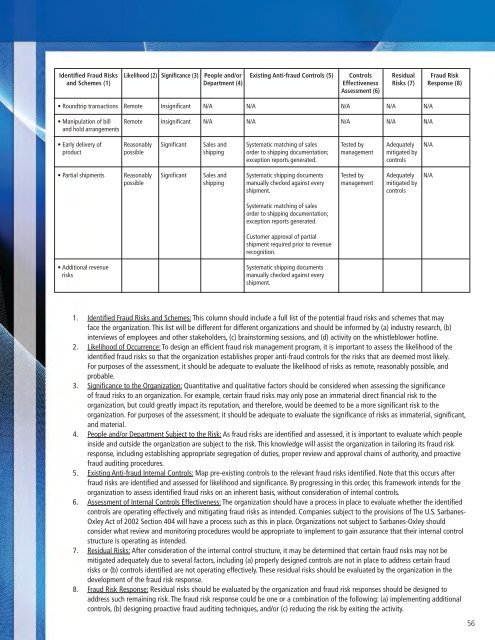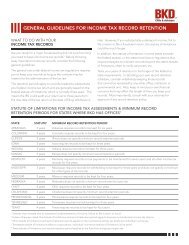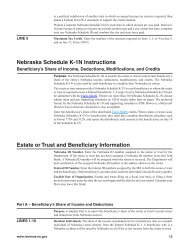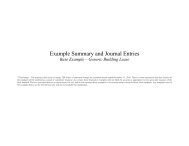acfe fraud prevention check-up - BKD
acfe fraud prevention check-up - BKD
acfe fraud prevention check-up - BKD
- No tags were found...
You also want an ePaper? Increase the reach of your titles
YUMPU automatically turns print PDFs into web optimized ePapers that Google loves.
Identified Fraud Risksand Schemes (1)Likelihood (2)Significance (3)People and/orDepartment (4)Existing Anti-<strong>fraud</strong> Controls (5)ControlsEffectivenessAssessment (6)ResidualRisks (7)Fraud RiskResponse (8)• Roundtrip transactionsRemoteInsignificantN/AN/AN/AN/AN/A• Manipulation of billand hold arrangementsRemoteInsignificantN/AN/AN/AN/AN/A• Early delivery ofproductReasonablypossibleSignificantSales andshippingSystematic matching of salesorder to shipping documentation;exception reports generated.Tested bymanagementAdequatelymitigated bycontrolsN/A• Partial shipmentsReasonablypossibleSignificantSales andshippingSystematic shipping documentsmanually <strong>check</strong>ed against everyshipment.Tested bymanagementAdequatelymitigated bycontrolsN/ASystematic matching of salesorder to shipping documentation;exception reports generated.Customer approval of partialshipment required prior to revenuerecognition.• Additional revenuerisksSystematic shipping documentsmanually <strong>check</strong>ed against everyshipment.1. Identified Fraud Risks and Schemes: This column should include a full list of the potential <strong>fraud</strong> risks and schemes that mayface the organization. This list will be different for different organizations and should be informed by (a) industry research, (b)interviews of employees and other stakeholders, (c) brainstorming sessions, and (d) activity on the whistleblower hotline.2. Likelihood of Occurrence: To design an efficient <strong>fraud</strong> risk management program, it is important to assess the likelihood of theidentified <strong>fraud</strong> risks so that the organization establishes proper anti-<strong>fraud</strong> controls for the risks that are deemed most likely.For purposes of the assessment, it should be adequate to evaluate the likelihood of risks as remote, reasonably possible, andprobable.3. Significance to the Organization: Quantitative and qualitative factors should be considered when assessing the significanceof <strong>fraud</strong> risks to an organization. For example, certain <strong>fraud</strong> risks may only pose an immaterial direct financial risk to theorganization, but could greatly impact its reputation, and therefore, would be deemed to be a more significant risk to theorganization. For purposes of the assessment, it should be adequate to evaluate the significance of risks as immaterial, significant,and material.4. People and/or Department Subject to the Risk: As <strong>fraud</strong> risks are identified and assessed, it is important to evaluate which peopleinside and outside the organization are subject to the risk. This knowledge will assist the organization in tailoring its <strong>fraud</strong> riskresponse, including establishing appropriate segregation of duties, proper review and approval chains of authority, and proactive<strong>fraud</strong> auditing procedures.5. Existing Anti-<strong>fraud</strong> Internal Controls: Map pre-existing controls to the relevant <strong>fraud</strong> risks identified. Note that this occurs after<strong>fraud</strong> risks are identified and assessed for likelihood and significance. By progressing in this order, this framework intends for theorganization to assess identified <strong>fraud</strong> risks on an inherent basis, without consideration of internal controls.6. Assessment of Internal Controls Effectiveness: The organization should have a process in place to evaluate whether the identifiedcontrols are operating effectively and mitigating <strong>fraud</strong> risks as intended. Companies subject to the provisions of The U.S. Sarbanes-Oxley Act of 2002 Section 404 will have a process such as this in place. Organizations not subject to Sarbanes-Oxley shouldconsider what review and monitoring procedures would be appropriate to implement to gain assurance that their internal controlstructure is operating as intended.7. Residual Risks: After consideration of the internal control structure, it may be determined that certain <strong>fraud</strong> risks may not bemitigated adequately due to several factors, including (a) properly designed controls are not in place to address certain <strong>fraud</strong>risks or (b) controls identified are not operating effectively. These residual risks should be evaluated by the organization in thedevelopment of the <strong>fraud</strong> risk response.8. Fraud Risk Response: Residual risks should be evaluated by the organization and <strong>fraud</strong> risk responses should be designed toaddress such remaining risk. The <strong>fraud</strong> risk response could be one or a combination of the following: (a) implementing additionalcontrols, (b) designing proactive <strong>fraud</strong> auditing techniques, and/or (c) reducing the risk by exiting the activity.56









